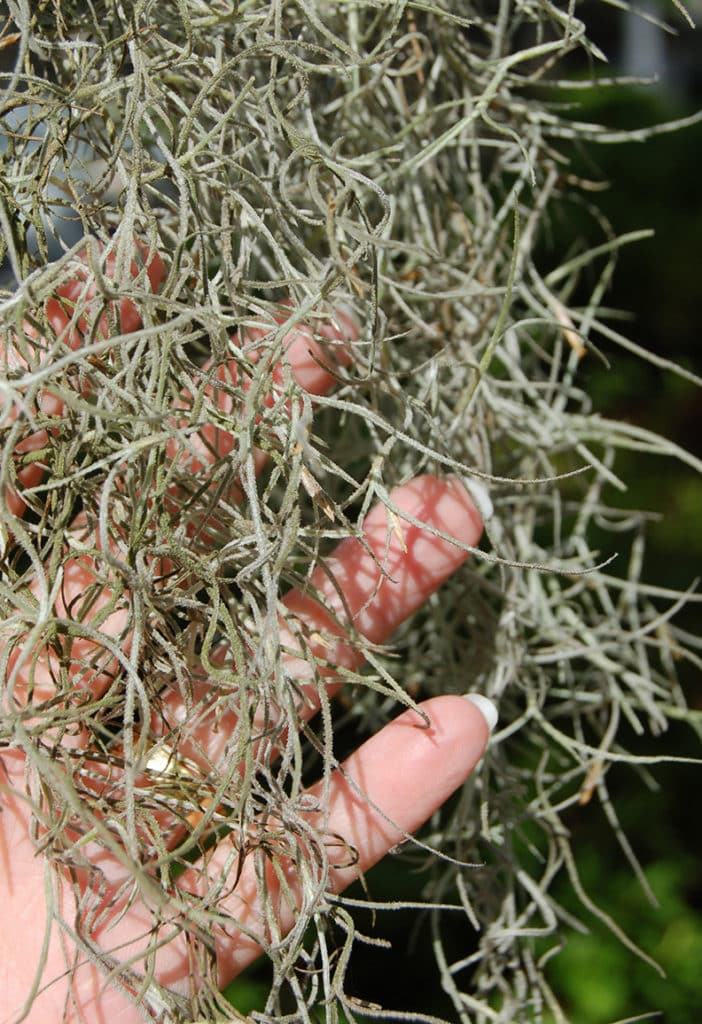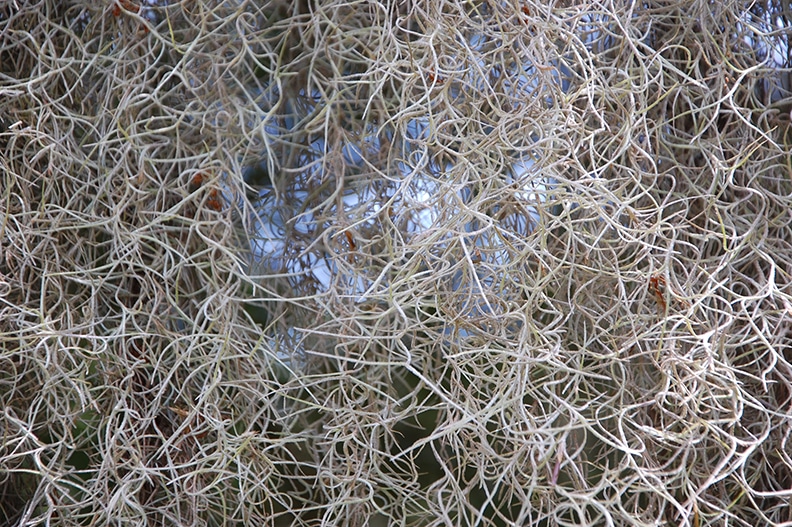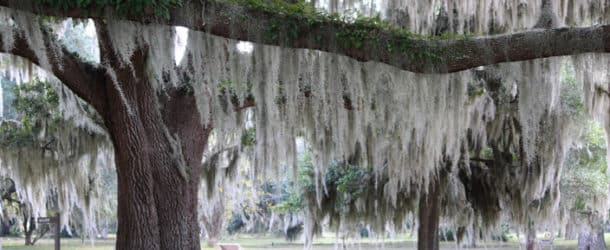It’s Not Moss And It’s Not Spanish
By Brad Goins
If you’ve spent your whole life in Louisiana, you’ve almost certainly heard of such scary creatures and figures as Rougarou, Loup Garou, Chupacabra, several versions of Sasquatch, Baron Samedi and the real-life Marie Laveau.
But even if you’re Louisianan right down to your bones, you may not have heard of Gorez Goz. Yet his story has quite a bit to do with Louisiana.
Gorez Goz was a crass, brutish Spanish Conquistador with an enormous, flowing beard. Centuries ago, he bought a beautiful Native American woman for a yard of gold lace and a bar of soap.
Goz was a scary man to look at. In fact, his appearance terrified the woman he bought. At the first sight, she took off running. Gorez Goz chased her; when she climbed up a tree, he followed her to the top.
The woman dove into the water of the bayou beneath the tree. Eventually, she escaped.
Gorez Goz didn’t fare nearly as well. His beard got caught up in the tree’s branches. He finally died there. Today, we can still see his grey beard on trees throughout the state — in the form of Spanish moss.
(There are several variants of the myth. In one, the Native American woman returns her suitor’s interest, but the Indian Chief forbids the relationship, tying the Conquistador to the branches of a tree. When he dies, his beard keeps growing — as Spanish moss. In another version, both lovers are killed. The woman’s black hair is hung in a tree, where it gradually turns gray, then spreads from tree to tree.)
Some of the French explorers and Spanish Conquistadors of the 17th and 18th centuries may have believed this or some other tale about Gorez Goz to be literally true. After all, neither group had ever seen Spanish moss before they’d come to the territory that would eventually be called Louisiana. They must have found the enormous, dark bayous to be lands of wonders, with some of the wonders being more than a little unsettling and hard to explain.
Today, we are tremendously better informed about Spanish moss than any Conquistador ever was. But even those who’ve spent lifetimes in the company of this exotic plant may not know all there is to know about it.
For Starters, Is Spanish Moss Really Moss?
When I think about how little the Spanish moss that hangs from tree branches resembles the moss I see on logs and rocks, I’m astonished that it has the name it has. At any rate, it turns out that Spanish moss certainly isn’t a moss. What it is is a “bromeliad.”

Many bromeliads live by connecting themselves to other plants. They get the nourishment they need from air, water and natural debris, and sometimes from the host plants.
While Spanish moss lives on the surface of trees, it doesn’t harm them in any way. It puts no roots into the trees; it gets no nourishment from the trees. Since it’s not a parasite, Spanish moss does just fine on dead trees, fences or power lines.
For Spanish moss, the tree is an object it can moor itself to so that it will stay in a place where it can get plenty of air and water and the natural debris carried by both.
The surface of Spanish moss has many tiny gray scales that are ideal for trapping water. Spanish moss also stores water so it can get through droughts. After a good rain, Spanish moss will have something of a greenish hue; in the midst of a drought, it will be solid gray.
It will seem to a Louisianan that Spanish moss is especially attracted to live oaks and cypress trees. But of course, the state has many of those two families of trees.
So How Did This Plant Get Its Name?
“Spanish moss” is a distinctive name for a distinctive plant. But where did the name come from? We already know the plant isn’t a form of moss. What about the rest of the name? Did Spanish moss come from Spain?
Nope. Says Miss Cellanious of Mental Floss, Spanish moss is “native to Mexico, Central America, South America, the U.S. and the Caribbean. In the U.S., it grows [in moist areas] from Texas to Virginia.” It’s especially widespread in the coastal areas that run along the shores of the Gulf of Mexico. As you might suspect, in this country, its preferred habitat is semi-tropical swampland — places with plenty of moisture in the air.
French explorers were the people who came up with an early version of the term “Spanish moss.” Native Americans referred to the growth with a term that sounded like “Itla-okla”; that term, they told the French, meant “tree hair.”
The French immediately made a connection with the long beards of the Spanish Conquistadors. They took to calling the growth “barbe Espagnol” — “Spanish beard.” Spaniards responded by dubbing the growth “cabello Francés” — “French hair.” But the French name won out and was standard usage for a while.
So how did “Spanish beard” become “Spanish moss”? If anyone knows, he’s not telling. The going theory is that at some point, people began to feel it was silly to call something that was obviously a plant a beard. “Moss” may have become part of the name because moss was an obvious example of a plant that grows on trees.
How Does Spanish Moss Spread?
Let’s look at a few more aspects of the way in which this unique plant functions.
Spanish moss uses pods and seeds to propagate itself. After the plant flowers, it produces brown pods that split apart when they’re mature. From these open pods come seeds that — in the word’s of LSU Ag’s Dan Gill — “are equipped with feathery parachutes that allow them to float through the air like dandelion seeds.”
As for the flowering of the Spanish moss plant, the blooms do produce perfume. So if you’ve ever had the feeling that you can sometimes smell Spanish moss, your intuition was right on target.
Spanish moss can also grow from “festoons” — small pieces of the plant that are broken off by birds or strong winds or rain. If a festoon lands on a tree in the right location, it can grow into mature Spanish moss.
A Few Drawbacks
The down side of Spanish moss isn’t very down. This isn’t a plant that can rip your skin apart or give you an agonizing rash. But on occasion, there can be drawbacks to the plant.

Although it would be unusual for a large cluster to grow on a weak, immature branch, it can happen, and at some point, the branch can break.
Although Spanish moss isn’t a parasite, there are occasions when it can do damage — at least to the interests of people. A very large amount of Spanish moss may keep a cash crop, such as pecans, from getting enough sun.
In practical terms, Spanish moss will never do any damage to shade trees. Still, some may have it removed from such trees. Not everyone likes the look of Spanish moss. And many hold the widespread, but erroneous, belief that the plant is a parasite that weakens the tree.
A Surprising Number Of Uses
You can’t use Spanish moss for feed. It has no nutrition.
But people have figured out a great many uses for the plant. In many past generations, it provided great practical benefits to people and was a key part of the culture of everyday life.
Native American women used it to make dresses before the settlers arrived.
Many readers will know that Louisiana settlers mixed Spanish moss with mud to make mortar for their houses. A few of the houses with this mortar are still standing. In “Le Vieux Ville” (The Old Town), which is located at the same site as the Louisiana Orphan Train Museum — 233 S. Academy in Opelousas — there’s a preserved Creole house (the “Venus House”) with a bedroom that contains a good deal of exposed Spanish moss mortar. Some of this mortar has buckled badly and is held in place by strategically placed studs from the modern era. But the walls are still intact, and one could take shelter in the room — or even live in it — if it were necessary. This preserved structure may not look very fancy. But it’s been standing since 1791, and the Spanish moss is still doing its job.
Dry moss makes good tinder and good mulch.
It can be made into blankets and rope.
It was once particularly sought after as a mattress filling. Wool attracts moths, but moths have no interest in Spanish moss. And Spanish moss was thought to keep mattresses cooler than other materials.
Since Spanish moss can serve as a home for snakes, bugs and spiders, settlers boiled it before they used it as a mattress stuffing.
In addition to serving as mattress stuffing, Spanish moss was put inside upholstery and car seats. It was most in demand as a stuffing for furniture.
Those who were serious about using Spanish moss as a stuffing let it dry for eight months so that the outer covering rotted away and only the pure strand of the moss was left.
Many Louisianans once made their money by processing Spanish moss. But the development of synthetic fibers gradually eliminated the use of the plant as a stuffing material. The last operating Spanish moss processing plant was located in Gainesville, Fla. It caught fire in 1958. The Spanish moss processing industry was over.
Of course, there’s still a small cottage industry of processing Spanish moss for tourists or collectors or those who would like to see it growing on their own trees.
Working With Spanish Moss
There’s no such thing as a herbicide for controlling or removing Spanish moss in trees. If you want it out, you’ll have to take it out manually or mechanically.
Since large bundles of Spanish moss can hold snakes or birds, it may work best to remove the plants with a long pole or a rake. Tree companies will sometimes remove Spanish moss in high branches.
There is some debate about whether people can get chiggers by removing Spanish moss. It’s worth the trouble to wear long sleeves and work gloves when one wants to handle the plant.
If your trees don’t have Spanish moss on them but you wish they did, simply put clumps of Spanish moss on your tree branches. If the moss doesn’t take, keep repeating the process until you get a batch of Spanish moss that thrives.
There is no sight in nature more beautiful than that of a Spanish moss-festooned live oak at twilight. You don’t need to go to an expansive bayou to experience this beauty. Just take a long walk in most parts of the Lake Area right after the sun sets.
















Comments are closed.